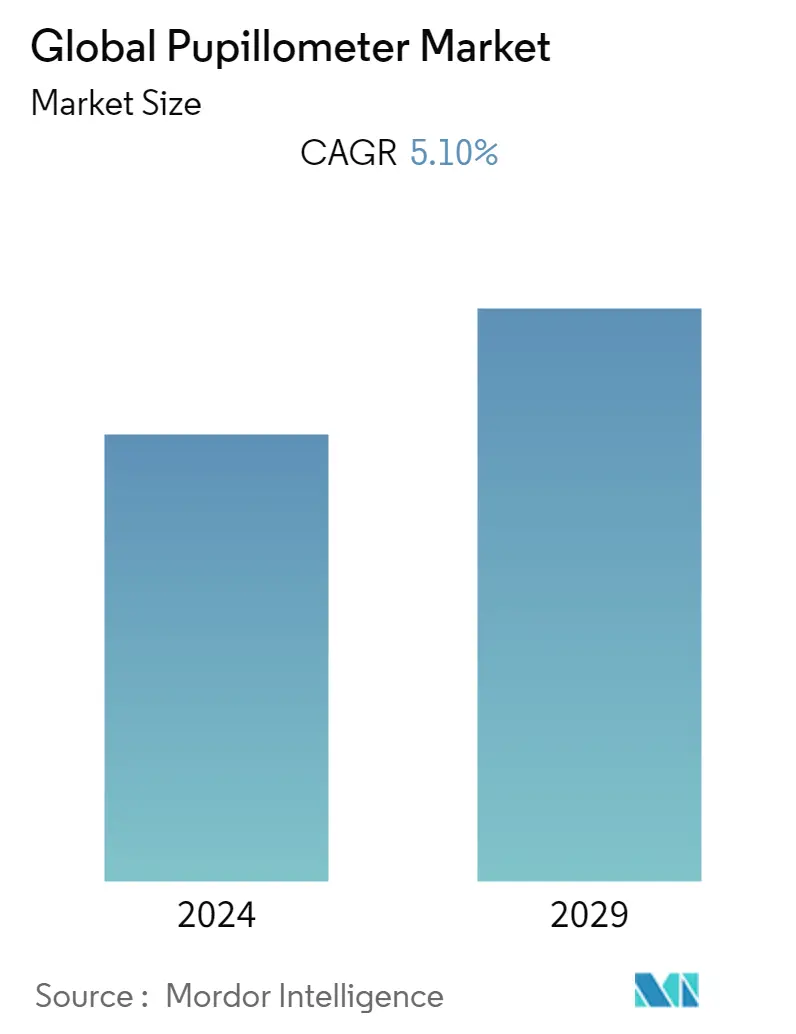Market Size of Global Pupillometer Industry

| Study Period | 2019 - 2029 |
| Base Year For Estimation | 2023 |
| Forecast Data Period | 2024 - 2029 |
| CAGR | 5.10 % |
| Fastest Growing Market | Asia-Pacific |
| Largest Market | North America |
Major Players.webp)
*Disclaimer: Major Players sorted in no particular order |
Need a report that reflects how COVID-19 has impacted this market and its growth?
Pupillometer Market Analysis
The pupillometer market is expected to register a CAGR of 5.1% over the forecast period (2022-2027).
The COVID-19 pandemic drastically affected the already overburdened public health systems in many countries. Additionally, the core focus of the healthcare industry shifted to pandemic crisis management. This led to challenges faced in hiring, retaining, and protecting technically trained, and encouraged health professionals. Moreover, the worldwide lockdowns led to a shortage of healthcare staff. Furthermore, the supply chain of medical devices around the world was also obstructed. In addition, the pupillometer market also faced detrimental impacts during the COVID-19 pandemic. There was a sharp decline in ophthalmology services during the pandemic. Hence, this leads to a decrease in demand for pupillometers.
Furthermore, coronavirus can enter the body through the eye's conjunctiva. Hence, ophthalmologists might be at high risk of getting infected. This is because of the proximity to patients during the examination, predisposing ophthalmologists to droplet transmission. Thus, the world health organization (WHO) commissioned precautionary measures to avoid contact with the eyes to reduce transmission. Therefore, as a cautionary measure, many ophthalmologists across the world suspended their practices temporarily. In certain countries, special guidelines were laid for ophthalmology practices, and services were suspended. For instance, the Government of India Ministry of Health and Family Welfare issued guidelines on safe ophthalmology practices in the Covid-19 scenario in December 2020. These guidelines were aimed at minimizing the spread of COVID-19 among the ophthalmic healthcare staff. Hence, the Eye care facilities in containment zones remained closed. Thus, these factors led to a decline in the demand for pupillometers in the year 2020 thereby affecting the studied market during the COVID-19 pandemic. However, the market is gradually recovering from the decline since the year 2021. This is because the medical device supply chain services resumed.
The major factor leading to the growth of the studied market includes the rise in awareness associated with pupillometers over manual pupillary examination coupled with technological advancements. Other factors that contribute to the growth of the market include, the surge in the prevalence of disorders requiring the use of pupillometer.
Over the years, manual pupil assessment remained a major way of obtaining pupillary information about a patient. This conventional technique involved the usage of a penlight or flashlight to manually evaluate pupil reactivity and a pupil gauge to estimate pupil size. However, manual pupillary assessment can lead to inaccuracies and inconsistencies. Furthermore, it can result in inter-examiner variability. Hence, pupillometers are preferred over manual assessment. This is because these optical devices are technically advanced. For instance, the new pupillometers have infrared cameras, an LED light source, a barcode scanner, Bluetooth-enabled data transfer, and other advanced features. In addition, features such as the barcode scanner eliminate the need for an external scanner. Hence, this avoids any transcription errors during manual entries of a patient ID. Furthermore, the novel noninvasive, handheld optical scanners available on the market can provide reliable and objective measurements of pupillary size, symmetry, and reactivity. For instance, the NPi-300 pupillometer system offered by NeurOptics, Inc. can quantify pupil reactivity on a numeric scale, and the Neurological Pupil index (NPi) allows rigorous interpretation and classification of the pupil response. The device also delivers information on whether the pupillary light reflex falls within the normal range or abnormal range. Furthermore, the device can also check if the light reflex is in, the atypical, immeasurable, or non-reactive range. Hence, these advantages make them a preferable choice among physicians.
Afferent pupillary defect (APD) is a measure of asymmetry which may occur with the optic nerve, brain tumors, retinal, or cerebral vascular disease, and amblyopia. It occurs specifically when the disease or disorder is presenting asymmetrically. Hence, the surge in prevalence of diseases such as brain tumors leads to a rise in demand for pupillometers which are used to detect APD in patients suffering from a brain tumor. For instance, according to an estimate by the American Society of Clinical Oncology (ASCO), 25,050 adults are estimated to be diagnosed with primary cancerous tumors of the brain and spinal cord in the United States in the year 2022.
In addition, neurological pupil index (NPi) testing is essential in a patient with diseases such as stroke, aneurysm, and cardiac arrest among others. Thus, the rise in prevalence of cardiac arrest also leads to a surge in demand for pupillometers thereby driving the growth of the market studied. For instance, The American Heart Association released and updated a report 'Heart and Stroke Statistics' in 2022. According to the report, each year in the United States there are more than 356,000 out-of-hospital cardiac arrests (OHCA).
Therefore, owing to the aforementioned factors the studied market is anticipated to witness growth over the analysis period. However, the high cost of pupillometers and lack of specialized clinicians impacts the penetration in emerging countries. This in turn affects the growth of the pupillometer market.
